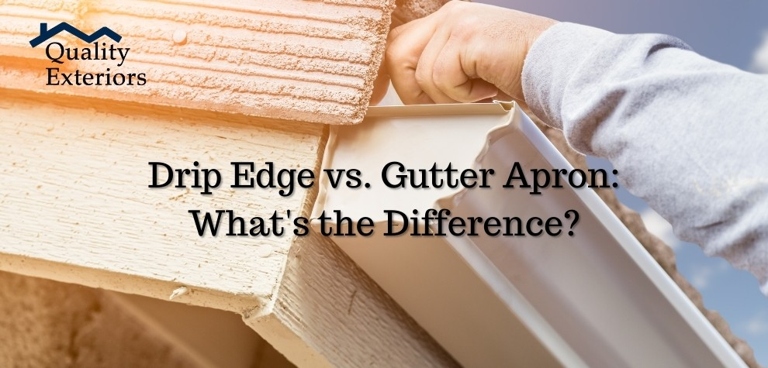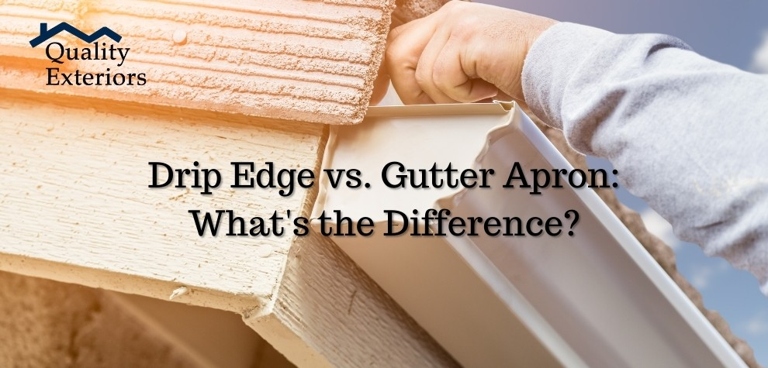In any home improvement or roofing project, two terms that are bound to come up are “gutter apron” and “drip edge.” While these two terms might be used interchangeably, they actually refer to two different things. In this article, we will explore the key differences between a gutter apron and a drip edge.
Gutter Apron Overview
Gutter aprons are one of the most important, but often overlooked, components of a gutter system. They are installed under the first course of shingles and extend past the gutter to help direct water into the gutter and away from the home. While they are not required by code in all areas, they are highly recommended by most gutter installers and manufacturers.

They are also used to help keep the first course of shingles from getting wet and deteriorating. They are installed at the edge of the roof and extend past the gutter to help direct water away from the home. Drip edges, on the other hand, are required by code in most areas.
Drip Edge Overview
This is known as a drip edge, and it serves an important purpose in protecting your home from water damage. If you have ever looked closely at the edge of a roof, you have likely noticed a small strip of metal or plastic that extends slightly beyond the edge of the shingles.
They are typically made of galvanized steel, aluminum, or PVC, and they help to direct water away from the edge of the roof and into the gutters. Drip edges are installed on both the eaves and rakes of a roof.

The overhang of the drip edge helps to keep the rain from hitting the edge of the shingles and causing them to curl or lift. Drip edges also help to prevent shingles from being damaged by wind-driven rain.
If you are unsure whether or not your home has drip edges, it is a good idea to have a roofing inspector take a look. While drip edges are not required by building code in all areas, they are highly recommended by most roofing professionals.
Gutter Aprons and Drip Edges Do the Same Things
Gutter aprons and drip edges are two types of gutter protection that serve similar purposes. Both are installed at the edge of your roof to help keep water from running behind your gutters and causing damage to your home. There are, however, some key differences between the two that you should be aware of.
Advantages of Installing a Drip Edge or Gutter Apron
Installing a drip edge or gutter apron on your home has many advantages. These two products work together to keep water away from your home’s foundation and prevent flooding and water damage.

Drip edges are installed on the edges of your roof. They extend beyond the edge of your roof and overhang your gutters. This overhang helps to keep water from running down the side of your home and into your gutters.
They extend out from your home’s fascia board and overhang your gutters. Gutter aprons are installed under your gutters. This overhang helps to keep water from running off your roof and into your gutters.
Both drip edges and gutter aprons are important in keeping water away from your home’s foundation. They help to prevent flooding and water damage.
Disadvantages of Installing a Drip Edge or Gutter Apron
While a drip edge or gutter apron can be an effective way to protect your roof, there are some disadvantages to installing one. It is used to protect the edge of the roof from water damage and to direct water into the gutters. A drip edge or gutter apron is a metal flashing that is installed over the edge of a roof.
Professional Installation Is Recommended
If you’re considering adding an apron or drip edge to your gutters, you may be wondering if professional installation is worth the extra cost. Here’s a look at the key differences between these two types of gutters to help you make a decision.
Make Your Choice
It is important when choosing materials for your home to select those that will best protect your investment. In this section, we will explore the key differences between gutter aprons and drip edges to help you make the best choice for your home.
Frequently Asked Questions
1. What is a gutter apron?
A gutter apron is a metal flashing that is installed underneath the shingles and over the gutter. The apron protects the gutter from water and debris that can clog it.
2. What is a drip edge?
A drip edge is a metal flashing that is installed at the edge of the roof. It helps to direct water away from the edge of the roof and into the gutter.
3. What are the key differences between a gutter apron and a drip edge?
The key difference between a gutter apron and a drip edge is that a gutter apron is installed underneath the shingles and over the gutter, while a drip edge is installed at the edge of the roof.
4. Do I need both a gutter apron and a drip edge?
It is not necessary to have both a gutter apron and a drip edge. However, having both will provide the best protection for your roof and gutter.
5. How do I choose between a gutter apron and a drip edge?
The best way to choose between a gutter apron and a drip edge is to consult with a professional roofer. They will be able to assess your roof and recommend the best option for you.
Final thoughts
In conclusion, gutter aprons and drip edges serve different purposes. Gutter aprons are installed on the front of the gutter and extend past the gutter’s edge. They are used to keep water from running behind the gutter and onto the fascia board. Drip edges are installed on the back of the gutter and extend past the gutter’s edge. They are used to keep water from running off the back of the gutter and onto the fascia board.
